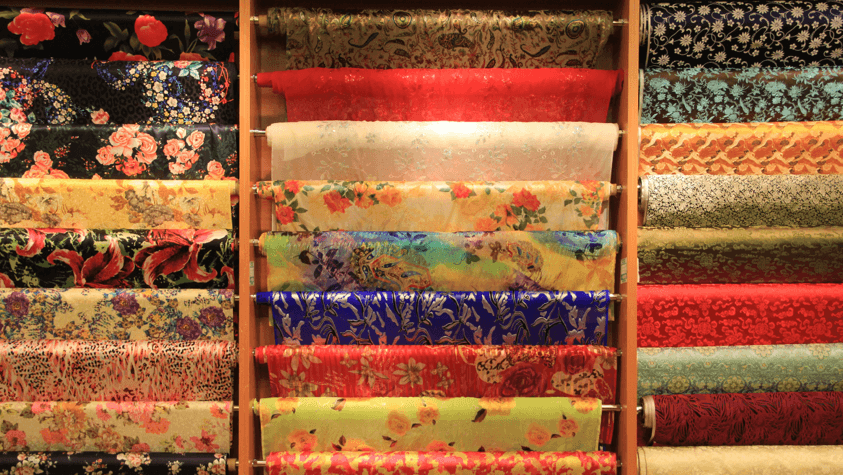By TACP Staff on July 30, 2019

Do you find yourself obsessing over fabric prints? If you are driven creatively, have an interest in emerging fashion and love exploring new techniques, you might enjoy an exciting and rewarding career a textile designer.
In their book about textile design, Understanding of Textiles, Collier, Bide and Tortora explain that the field of textile design enables individuals to apply their artistic talents to specific uses, such as the demonstration and application of fabric construction, the general development of textile designs, and the production of fabric designs that are specifically suitable for use in furnishings, apparel, and accessories. In other words, textile designers apply a wide range of fabric embellishments and manipulation techniques to create their personal designs.
A textile designer works closely with clients and design teams to create unique fabrics using a variety of design concepts and media, including textile CAD software programs, such as Pro-Weave, 3D Mapping, Photoshop, and other software suites, to create both single and regenerated concepts.
In order to create and utilize new concepts and ideas, the textile designer must first possess excellent communication skills to discuss, understand, and interpret the requirements and needs of his or her clients. The designer must also understand the basic principles of design research to assess the distinction of a specific design or designs; is it a current design, are the colors attractive and do they harmonize?
In addition to communication skills, textile designers must have strong organizational and computer skills. They must possess the ability to analyze and interpret test data and compile presentations; working along with creative teams of textile engineers, project managers, and graphic designers.
While a career as a textile designer has no specific educational requirements, textile designers often have degrees in surface design, fashion design, art and design, or textile design. Through proper training, prospective textile designers gain knowledge of the entire fabric design process. They learn to analyze and understand the various textile properties, such as weight, material, flammability and durability, and how the textile will be used, then base their designs on these factors. Even more importantly, they learn how to utilize textures, patterns and color through experimentation with printing, dying, manipulation, and embellishment techniques.
Schools that teach the fundamentals of textile design use specific principles to organize the structural elements of a given design. The principles include unity, balance, emphasis, proportion, and rhythm. The way these principles are applied affects the outcomes of the design.
Textile designers must also possess the design skills necessary to carry out the production of design samples and sketches, and the ability to create client presentations using various printed or digital designs; whether written, draw, or verbal. Knowledge of sewing or weaving, graphic design, and line drawing are also helpful skills to have. These design methods support the textile design work and determine final outcomes; positive or negative.
Color theory in textile design offers the guidelines and general principles that can help a textile designer create aesthetically pleasing color combinations. Analogies of tones, contrasts, and colors are all important elements used routinely in this discipline. Knowledge of luminosity, the solar spectrum, pigment theory, and color definitions are also important for all textile designers to have.
Although approaches can vary, there are usually two major techniques used in textile design; painting and art-based techniques. Techniques often applied by textile designers include airbrush, splatter or spraying, stippling, hatching, dry brush techniques, shading, sponge painting, and marbling, among others. Textile printing-based techniques commonly include batik, tie-dye, ikat, kalamkari, block printing, screen printing, stenciling, and transfer printing.
Building a strong portfolio is a crucial step in getting your foot in the door in the textile design industry. A designer’s portfolio is used to win job contracts, to demonstrate competency in the field, and to showcase original textiles. It should be carefully organized to illustrate a wide range of capabilities and skills.
Portfolios can be either physical or digital, but the textile designer can achieve better outreach by having both types, and both should be well organized. A physical portfolio should include at least twenty pages of original designs. A digital portfolio should have no less than thirty. Each portfolio should be tailored especially to the viewing audience(s) and should include appropriate examples for the role the textile designer will play in each job. Annotations and notes should be included on each page to give the viewer a greater idea of the context of each example. It is also a good idea to mention techniques used, the theory behind each design, and justification for its usage.
The goal of branding is to establish brand equity, brand awareness and brand loyalty to affect a brand image. Personal branding in the field of textile design identifies the individual textile designer as a marketable entity. It is used to differentiate oneself from the crowd by highlighting your particular talents and accomplishments. Personal branding can include the use of stationary, business cards, brochures, and other pertinent printed matter, as well as a strong digital presence through a website, social media outlets, and related professional organizations.
For many textile designers, industry success is dependent on making the right connections. The goal is to establish enduring and mutually beneficial relationships with clients and other people in the industry. A good place to start is in school. Many schools have outreach and placement programs that can put designers in touch with other industry professionals. Professional organizations such as The Textile Society for the Study of the History, Art & Design of Textiles, The American Textile Manufacturers Institute, and The National Textile Center all have networking and referral possibilities. There are also trade publications that can be used for networking purposes. For instance, Textile Service Magazine has a directory of leading textile industry professionals and professional organizations that can be used for networking, and ultimately getting noticed.

The Art Career Project is a trusted resource for emerging and professional artists.